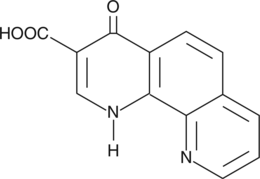Chemicals
Showing 2851–3000 of 41137 results
-
1,3-Distearoyl glycerol is a diacylglycerol that contains stearic acid (Item No. 10011298) at the sn-1 and sn-3 positions. It has been found in wheat bran extract.{51025} 1,3-Distearoyl glycerol has been used in the synthesis of prodrug forms of the non-steroidal anti-inflammatory drugs (NSAIDs) ibuprofen, naproxen (Item No. 70290), and diclofenac (Item Nos. 70680 | 22983) that have reduced ulcerogenicity.{45629,45630,45631}
Brand:CaymanSKU:26946 - 100 mgAvailable on backorder
1,3-Distearoyl glycerol is a diacylglycerol that contains stearic acid (Item No. 10011298) at the sn-1 and sn-3 positions. It has been found in wheat bran extract.{51025} 1,3-Distearoyl glycerol has been used in the synthesis of prodrug forms of the non-steroidal anti-inflammatory drugs (NSAIDs) ibuprofen, naproxen (Item No. 70290), and diclofenac (Item Nos. 70680 | 22983) that have reduced ulcerogenicity.{45629,45630,45631}
Brand:CaymanSKU:26946 - 25 mgAvailable on backorder
1,3-Distearoyl glycerol is a diacylglycerol that contains stearic acid (Item No. 10011298) at the sn-1 and sn-3 positions. It has been found in wheat bran extract.{51025} 1,3-Distearoyl glycerol has been used in the synthesis of prodrug forms of the non-steroidal anti-inflammatory drugs (NSAIDs) ibuprofen, naproxen (Item No. 70290), and diclofenac (Item Nos. 70680 | 22983) that have reduced ulcerogenicity.{45629,45630,45631}
Brand:CaymanSKU:26946 - 50 mgAvailable on backorder
1,3-Distearoyl-2-elaidoyl glycerol is a triacylglycerol that contains stearic acid (Item No. 10011298) at the sn-1 and sn-3 positions and elaidic acid (Item No. 90250) at the sn-2 position.
Brand:CaymanSKU:28864 - 1 mgAvailable on backorder
1,3-Distearoyl-2-elaidoyl glycerol is a triacylglycerol that contains stearic acid (Item No. 10011298) at the sn-1 and sn-3 positions and elaidic acid (Item No. 90250) at the sn-2 position.
Brand:CaymanSKU:28864 - 10 mgAvailable on backorder
1,3-Distearoyl-2-elaidoyl glycerol is a triacylglycerol that contains stearic acid (Item No. 10011298) at the sn-1 and sn-3 positions and elaidic acid (Item No. 90250) at the sn-2 position.
Brand:CaymanSKU:28864 - 25 mgAvailable on backorder
1,3-Distearoyl-2-elaidoyl glycerol is a triacylglycerol that contains stearic acid (Item No. 10011298) at the sn-1 and sn-3 positions and elaidic acid (Item No. 90250) at the sn-2 position.
Brand:CaymanSKU:28864 - 5 mgAvailable on backorder
1,3-Distearoyl-2-lauroyl glycerol is a triacylglycerol that contains stearic acid (Item No. 10011298) at the sn-1 and sn-3 positions and lauric acid (Item No. 10006626) at the sn-2 position. It has been found in butterfat.{46189}
Brand:CaymanSKU:28552 - 1 mgAvailable on backorder
1,3-Distearoyl-2-lauroyl glycerol is a triacylglycerol that contains stearic acid (Item No. 10011298) at the sn-1 and sn-3 positions and lauric acid (Item No. 10006626) at the sn-2 position. It has been found in butterfat.{46189}
Brand:CaymanSKU:28552 - 10 mgAvailable on backorder
1,3-Distearoyl-2-lauroyl glycerol is a triacylglycerol that contains stearic acid (Item No. 10011298) at the sn-1 and sn-3 positions and lauric acid (Item No. 10006626) at the sn-2 position. It has been found in butterfat.{46189}
Brand:CaymanSKU:28552 - 25 mgAvailable on backorder
1,3-Distearoyl-2-lauroyl glycerol is a triacylglycerol that contains stearic acid (Item No. 10011298) at the sn-1 and sn-3 positions and lauric acid (Item No. 10006626) at the sn-2 position. It has been found in butterfat.{46189}
Brand:CaymanSKU:28552 - 5 mgAvailable on backorder
1,3-Distearoyl-2-linoleoyl glycerol is a triacylglycerol that contains stearic acid (Item No. 10011298) at the sn-1 and sn-3 positions and linoleic acid (Item Nos. 90150 | 90150.1 | 21909) at the sn-2 position. It has been found in cocoa butter and in cocoa butter equivalents (CBEs) containing shea stearin and palm mid fraction.{46187}
Brand:CaymanSKU:26967 - 1 mgAvailable on backorder
1,3-Distearoyl-2-linoleoyl glycerol is a triacylglycerol that contains stearic acid (Item No. 10011298) at the sn-1 and sn-3 positions and linoleic acid (Item Nos. 90150 | 90150.1 | 21909) at the sn-2 position. It has been found in cocoa butter and in cocoa butter equivalents (CBEs) containing shea stearin and palm mid fraction.{46187}
Brand:CaymanSKU:26967 - 10 mgAvailable on backorder
1,3-Distearoyl-2-linoleoyl glycerol is a triacylglycerol that contains stearic acid (Item No. 10011298) at the sn-1 and sn-3 positions and linoleic acid (Item Nos. 90150 | 90150.1 | 21909) at the sn-2 position. It has been found in cocoa butter and in cocoa butter equivalents (CBEs) containing shea stearin and palm mid fraction.{46187}
Brand:CaymanSKU:26967 - 25 mgAvailable on backorder
1,3-Distearoyl-2-linoleoyl glycerol is a triacylglycerol that contains stearic acid (Item No. 10011298) at the sn-1 and sn-3 positions and linoleic acid (Item Nos. 90150 | 90150.1 | 21909) at the sn-2 position. It has been found in cocoa butter and in cocoa butter equivalents (CBEs) containing shea stearin and palm mid fraction.{46187}
Brand:CaymanSKU:26967 - 5 mgAvailable on backorder
1,3-Distearoyl-2-myristoyl glycerol is a triacylglycerol that contains stearic acid (Item No. 10011298) at the sn-1 and sn-3 positions and myristic acid (Item No. 13351) at the sn-2 position. It has been found in butterfat.{46189}
Brand:CaymanSKU:28860 - 1 mgAvailable on backorder
1,3-Distearoyl-2-myristoyl glycerol is a triacylglycerol that contains stearic acid (Item No. 10011298) at the sn-1 and sn-3 positions and myristic acid (Item No. 13351) at the sn-2 position. It has been found in butterfat.{46189}
Brand:CaymanSKU:28860 - 10 mgAvailable on backorder
1,3-Distearoyl-2-myristoyl glycerol is a triacylglycerol that contains stearic acid (Item No. 10011298) at the sn-1 and sn-3 positions and myristic acid (Item No. 13351) at the sn-2 position. It has been found in butterfat.{46189}
Brand:CaymanSKU:28860 - 25 mgAvailable on backorder
1,3-Distearoyl-2-myristoyl glycerol is a triacylglycerol that contains stearic acid (Item No. 10011298) at the sn-1 and sn-3 positions and myristic acid (Item No. 13351) at the sn-2 position. It has been found in butterfat.{46189}
Brand:CaymanSKU:28860 - 5 mgAvailable on backorder
1,3-Distearoyl-2-oleoyl glycerol is a triacylglycerol that contains stearic acid (Item No. 10011298) at the sn-1 and sn-3 positions and oleic acid (Item Nos. 90260 | 24659) at the sn-2 position. It has been found in Kpangnana, Chinese tallow, and cocoa butters.{43840} 1,3-Distearoyl-2-oleoyl glycerol increases the phagocytic function of reticulo-endothelial cells in mice when administered at doses of 5 and 10 mg per animal.{45214}
Brand:CaymanSKU:27163 - 10 mgAvailable on backorder
1,3-Distearoyl-2-oleoyl glycerol is a triacylglycerol that contains stearic acid (Item No. 10011298) at the sn-1 and sn-3 positions and oleic acid (Item Nos. 90260 | 24659) at the sn-2 position. It has been found in Kpangnana, Chinese tallow, and cocoa butters.{43840} 1,3-Distearoyl-2-oleoyl glycerol increases the phagocytic function of reticulo-endothelial cells in mice when administered at doses of 5 and 10 mg per animal.{45214}
Brand:CaymanSKU:27163 - 25 mgAvailable on backorder
1,3-Distearoyl-2-oleoyl glycerol is a triacylglycerol that contains stearic acid (Item No. 10011298) at the sn-1 and sn-3 positions and oleic acid (Item Nos. 90260 | 24659) at the sn-2 position. It has been found in Kpangnana, Chinese tallow, and cocoa butters.{43840} 1,3-Distearoyl-2-oleoyl glycerol increases the phagocytic function of reticulo-endothelial cells in mice when administered at doses of 5 and 10 mg per animal.{45214}
Brand:CaymanSKU:27163 - 5 mgAvailable on backorder
1,3-Distearoyl-2-oleoyl glycerol is a triacylglycerol that contains stearic acid (Item No. 10011298) at the sn-1 and sn-3 positions and oleic acid (Item Nos. 90260 | 24659) at the sn-2 position. It has been found in Kpangnana, Chinese tallow, and cocoa butters.{43840} 1,3-Distearoyl-2-oleoyl glycerol increases the phagocytic function of reticulo-endothelial cells in mice when administered at doses of 5 and 10 mg per animal.{45214}
Brand:CaymanSKU:27163 - 50 mgAvailable on backorder
1,3-Distearoyl-2-palmitoyl glycerol is a triacylglycerol that contains stearic acid (Item No. 10011298) at the sn-1 and sn-3 positions and palmitic acid (Item No. 10006627) at the sn-2 position. It has been found in bovine milk fat.{46220}
Brand:CaymanSKU:27065 - 1 mgAvailable on backorder
1,3-Distearoyl-2-palmitoyl glycerol is a triacylglycerol that contains stearic acid (Item No. 10011298) at the sn-1 and sn-3 positions and palmitic acid (Item No. 10006627) at the sn-2 position. It has been found in bovine milk fat.{46220}
Brand:CaymanSKU:27065 - 10 mgAvailable on backorder
1,3-Distearoyl-2-palmitoyl glycerol is a triacylglycerol that contains stearic acid (Item No. 10011298) at the sn-1 and sn-3 positions and palmitic acid (Item No. 10006627) at the sn-2 position. It has been found in bovine milk fat.{46220}
Brand:CaymanSKU:27065 - 25 mgAvailable on backorder
1,3-Distearoyl-2-palmitoyl glycerol is a triacylglycerol that contains stearic acid (Item No. 10011298) at the sn-1 and sn-3 positions and palmitic acid (Item No. 10006627) at the sn-2 position. It has been found in bovine milk fat.{46220}
Brand:CaymanSKU:27065 - 5 mgAvailable on backorder
1,3-Ditridecanoyl glycerol is a diacylglycerol that contains tridecanoic acid (Item No. 19725) at the sn-1 and sn-3 positions.
Brand:CaymanSKU:26995 - 1 mgAvailable on backorder
1,3-Ditridecanoyl glycerol is a diacylglycerol that contains tridecanoic acid (Item No. 19725) at the sn-1 and sn-3 positions.
Brand:CaymanSKU:26995 - 10 mgAvailable on backorder
1,3-Ditridecanoyl glycerol is a diacylglycerol that contains tridecanoic acid (Item No. 19725) at the sn-1 and sn-3 positions.
Brand:CaymanSKU:26995 - 25 mgAvailable on backorder
1,3-Ditridecanoyl glycerol is a diacylglycerol that contains tridecanoic acid (Item No. 19725) at the sn-1 and sn-3 positions.
Brand:CaymanSKU:26995 - 5 mgAvailable on backorder
1,3-PBIT is a potent inhibitor of iNOS with a Ki of 47 nM compared to Ki values for eNOS and nNOS are 9 and 0.25 µM, respectively, for the purified human enzymes.{1292} Its inhibition in whole cells is greatly diminished, presumably to poor membrane permeability.
Brand:CaymanSKU:81500 - 10 mgAvailable on backorder
1,3-PBIT is a potent inhibitor of iNOS with a Ki of 47 nM compared to Ki values for eNOS and nNOS are 9 and 0.25 µM, respectively, for the purified human enzymes.{1292} Its inhibition in whole cells is greatly diminished, presumably to poor membrane permeability.
Brand:CaymanSKU:81500 - 100 mgAvailable on backorder
1,3-PBIT is a potent inhibitor of iNOS with a Ki of 47 nM compared to Ki values for eNOS and nNOS are 9 and 0.25 µM, respectively, for the purified human enzymes.{1292} Its inhibition in whole cells is greatly diminished, presumably to poor membrane permeability.
Brand:CaymanSKU:81500 - 25 mgAvailable on backorder
1,3-PBIT is a potent inhibitor of iNOS with a Ki of 47 nM compared to Ki values for eNOS and nNOS are 9 and 0.25 µM, respectively, for the purified human enzymes.{1292} Its inhibition in whole cells is greatly diminished, presumably to poor membrane permeability.
Brand:CaymanSKU:81500 - 50 mgAvailable on backorder
1,3,4,6-Tetra-O-acetyl-2-azido-2-deoxy-α-D-mannopyranose is an analog of N-acetylmannosamine (ManNAc) and a building block.{53626,53627} It has been used as a precursor in the synthesis of differently substituted trimers of the group A N. meningitidis capsular polysaccharide repeating unit for use in immunological experiments.{53627} It has also been used in the synthesis of fluorescent probes for lysosomal labeling.{53628}
Brand:CaymanSKU:30542 - 10 mgAvailable on backorder
1,3,4,6-Tetra-O-acetyl-2-azido-2-deoxy-α-D-mannopyranose is an analog of N-acetylmannosamine (ManNAc) and a building block.{53626,53627} It has been used as a precursor in the synthesis of differently substituted trimers of the group A N. meningitidis capsular polysaccharide repeating unit for use in immunological experiments.{53627} It has also been used in the synthesis of fluorescent probes for lysosomal labeling.{53628}
Brand:CaymanSKU:30542 - 100 mgAvailable on backorder
1,3,4,6-Tetra-O-acetyl-2-azido-2-deoxy-α-D-mannopyranose is an analog of N-acetylmannosamine (ManNAc) and a building block.{53626,53627} It has been used as a precursor in the synthesis of differently substituted trimers of the group A N. meningitidis capsular polysaccharide repeating unit for use in immunological experiments.{53627} It has also been used in the synthesis of fluorescent probes for lysosomal labeling.{53628}
Brand:CaymanSKU:30542 - 250 mgAvailable on backorder
1,3,4,6-Tetra-O-acetyl-2-azido-2-deoxy-α-D-mannopyranose is an analog of N-acetylmannosamine (ManNAc) and a building block.{53626,53627} It has been used as a precursor in the synthesis of differently substituted trimers of the group A N. meningitidis capsular polysaccharide repeating unit for use in immunological experiments.{53627} It has also been used in the synthesis of fluorescent probes for lysosomal labeling.{53628}
Brand:CaymanSKU:30542 - 50 mgAvailable on backorder
1,3,6,8-Pyrenetetrasulfonic acid is an intermediate in the synthesis of the color additive pyranine.{54358} It has been used to stabilize intermolecular interactions for the crystallization of L. mexicana pyruvate kinase.{54359}
Brand:CaymanSKU:29980 - 1 gAvailable on backorder
1,3,6,8-Pyrenetetrasulfonic acid is an intermediate in the synthesis of the color additive pyranine.{54358} It has been used to stabilize intermolecular interactions for the crystallization of L. mexicana pyruvate kinase.{54359}
Brand:CaymanSKU:29980 - 10 gAvailable on backorder
1,3,6,8-Pyrenetetrasulfonic acid is an intermediate in the synthesis of the color additive pyranine.{54358} It has been used to stabilize intermolecular interactions for the crystallization of L. mexicana pyruvate kinase.{54359}
Brand:CaymanSKU:29980 - 5 gAvailable on backorder
1,3,6,8-Pyrenetetrasulfonic acid is an intermediate in the synthesis of the color additive pyranine.{54358} It has been used to stabilize intermolecular interactions for the crystallization of L. mexicana pyruvate kinase.{54359}
Brand:CaymanSKU:29980 - 500 mgAvailable on backorder
1,3,7-Trimethyluric acid is a derivative of uric acid (Item No. 16219) and a metabolite of caffeine (Item No. 14118).{58128} It is formed from caffeine by the cytochrome P450 (CYP) isoform CYP3A4. 1,3,7-Trimethyluric acid (500 µM) scavenges hydroxyl radicals in a cell-free assay and inhibits t-butyl hydroperoxide-induced lipid peroxidation by 56.5% in isolated human erythrocyte membranes.{58129}
Brand:CaymanSKU:-Out of stock
1,3,7-Trimethyluric acid is a derivative of uric acid (Item No. 16219) and a metabolite of caffeine (Item No. 14118).{58128} It is formed from caffeine by the cytochrome P450 (CYP) isoform CYP3A4. 1,3,7-Trimethyluric acid (500 µM) scavenges hydroxyl radicals in a cell-free assay and inhibits t-butyl hydroperoxide-induced lipid peroxidation by 56.5% in isolated human erythrocyte membranes.{58129}
Brand:CaymanSKU:-Out of stock
1,3,7-Trimethyluric acid is a derivative of uric acid (Item No. 16219) and a metabolite of caffeine (Item No. 14118).{58128} It is formed from caffeine by the cytochrome P450 (CYP) isoform CYP3A4. 1,3,7-Trimethyluric acid (500 µM) scavenges hydroxyl radicals in a cell-free assay and inhibits t-butyl hydroperoxide-induced lipid peroxidation by 56.5% in isolated human erythrocyte membranes.{58129}
Brand:CaymanSKU:-Out of stock
1,3,7-Trimethyluric acid is a derivative of uric acid (Item No. 16219) and a metabolite of caffeine (Item No. 14118).{58128} It is formed from caffeine by the cytochrome P450 (CYP) isoform CYP3A4. 1,3,7-Trimethyluric acid (500 µM) scavenges hydroxyl radicals in a cell-free assay and inhibits t-butyl hydroperoxide-induced lipid peroxidation by 56.5% in isolated human erythrocyte membranes.{58129}
Brand:CaymanSKU:-Out of stock
1,3,7-Trimethyluric acid-d9 is intended for use as an internal standard for the quantification of 1,3,7-trimethyluric acid (Item No. 16949) by GC- or LC-MS. 1,3,7-Trimethyluric acid is a derivative of uric acid (Item No. 16219) and a metabolite of caffeine (Item No. 14118).{58128} It is formed from caffeine by the cytochrome P450 (CYP) isoform CYP3A4. 1,3,7-Trimethyluric acid (500 µM) scavenges hydroxyl radicals in a cell-free assay and inhibits t-butyl hydroperoxide-induced lipid peroxidation by 56.5% in isolated human erythrocyte membranes.{58129}
Brand:CaymanSKU:9003567 - 1 mgAvailable on backorder
1,3,7-Trimethyluric acid-d9 is intended for use as an internal standard for the quantification of 1,3,7-trimethyluric acid (Item No. 16949) by GC- or LC-MS. 1,3,7-Trimethyluric acid is a derivative of uric acid (Item No. 16219) and a metabolite of caffeine (Item No. 14118).{58128} It is formed from caffeine by the cytochrome P450 (CYP) isoform CYP3A4. 1,3,7-Trimethyluric acid (500 µM) scavenges hydroxyl radicals in a cell-free assay and inhibits t-butyl hydroperoxide-induced lipid peroxidation by 56.5% in isolated human erythrocyte membranes.{58129}
Brand:CaymanSKU:9003567 - 10 mgAvailable on backorder
1,3,7-Trimethyluric acid-d9 is intended for use as an internal standard for the quantification of 1,3,7-trimethyluric acid (Item No. 16949) by GC- or LC-MS. 1,3,7-Trimethyluric acid is a derivative of uric acid (Item No. 16219) and a metabolite of caffeine (Item No. 14118).{58128} It is formed from caffeine by the cytochrome P450 (CYP) isoform CYP3A4. 1,3,7-Trimethyluric acid (500 µM) scavenges hydroxyl radicals in a cell-free assay and inhibits t-butyl hydroperoxide-induced lipid peroxidation by 56.5% in isolated human erythrocyte membranes.{58129}
Brand:CaymanSKU:9003567 - 25 mgAvailable on backorder
1,3,7-Trimethyluric acid-d9 is intended for use as an internal standard for the quantification of 1,3,7-trimethyluric acid (Item No. 16949) by GC- or LC-MS. 1,3,7-Trimethyluric acid is a derivative of uric acid (Item No. 16219) and a metabolite of caffeine (Item No. 14118).{58128} It is formed from caffeine by the cytochrome P450 (CYP) isoform CYP3A4. 1,3,7-Trimethyluric acid (500 µM) scavenges hydroxyl radicals in a cell-free assay and inhibits t-butyl hydroperoxide-induced lipid peroxidation by 56.5% in isolated human erythrocyte membranes.{58129}
Brand:CaymanSKU:9003567 - 5 mgAvailable on backorder
1,4-Benzoquinone is a toxic metabolite of benzene.{47532} It is formed via hepatic metabolism of benzene to 1,4-hydroquinone followed by myeloperoxidase processing of 1,4-hydroquinone in bone marrow.{47533} 1,4-Benzoquinone decreases levels of cytochrome P450 in a concentration-dependent manner in minipig liver microsomes.{47532} It induces DNA mutations in human W138-VA13 and mouse HL18 cells.{47534} 1,4-Benzoquinone (10 and 20 μM) disrupts mitochondrial membrane potential and reduces viability, increases production of reactive oxygen species (ROS), and induces apoptosis in a concentration-dependent manner in HL-60 cells.{47535}
Brand:CaymanSKU:27560 - 100 gAvailable on backorder
Benzylpiperazines (BZP) are stimulant drugs which inhibit monoamine uptake.{20498,20500} BZP and substituted derivatives, such as 1-(3,4-methylenedioxybenzyl)piperazine, have been identified as designer drugs or drugs of abuse.{19508,20497} 1,4-Dibenzylpiperazine (hydrochloride) is a common impurity produced as a reaction byproduct during the synthesis of BZP. The biological and toxicological properties of this compound are not known. This product is intended for forensic applications.
Brand:CaymanSKU:11206 - 10 mgAvailable on backorder
Benzylpiperazines (BZP) are stimulant drugs which inhibit monoamine uptake.{20498,20500} BZP and substituted derivatives, such as 1-(3,4-methylenedioxybenzyl)piperazine, have been identified as designer drugs or drugs of abuse.{19508,20497} 1,4-Dibenzylpiperazine (hydrochloride) is a common impurity produced as a reaction byproduct during the synthesis of BZP. The biological and toxicological properties of this compound are not known. This product is intended for forensic applications.
Brand:CaymanSKU:11206 - 100 mgAvailable on backorder
Benzylpiperazines (BZP) are stimulant drugs which inhibit monoamine uptake.{20498,20500} BZP and substituted derivatives, such as 1-(3,4-methylenedioxybenzyl)piperazine, have been identified as designer drugs or drugs of abuse.{19508,20497} 1,4-Dibenzylpiperazine (hydrochloride) is a common impurity produced as a reaction byproduct during the synthesis of BZP. The biological and toxicological properties of this compound are not known. This product is intended for forensic applications.
Brand:CaymanSKU:11206 - 50 mgAvailable on backorder
1,4-dideoxy-1,4-imino-D-Arabinitol (DAB) is an inhibitor of glycogen phosphorylase, a key enzyme in glycogenolysis. It inhibits glycogenolysis in isolated liver cells (IC50 = 1.0 µM) and in homogenates of cerebral cortex and cerebellum (IC50s = 463 and 383 nM, respectively).{32709,32710,32714} DAB is used to inhibit glycogenolysis, in liver and in brain, in various animal models.{32711,32712,32713}
Brand:CaymanSKU:20939 -Out of stock
1,4-dideoxy-1,4-imino-D-Arabinitol (DAB) is an inhibitor of glycogen phosphorylase, a key enzyme in glycogenolysis. It inhibits glycogenolysis in isolated liver cells (IC50 = 1.0 µM) and in homogenates of cerebral cortex and cerebellum (IC50s = 463 and 383 nM, respectively).{32709,32710,32714} DAB is used to inhibit glycogenolysis, in liver and in brain, in various animal models.{32711,32712,32713}
Brand:CaymanSKU:20939 -Out of stock
1,4-dideoxy-1,4-imino-D-Arabinitol (DAB) is an inhibitor of glycogen phosphorylase, a key enzyme in glycogenolysis. It inhibits glycogenolysis in isolated liver cells (IC50 = 1.0 µM) and in homogenates of cerebral cortex and cerebellum (IC50s = 463 and 383 nM, respectively).{32709,32710,32714} DAB is used to inhibit glycogenolysis, in liver and in brain, in various animal models.{32711,32712,32713}
Brand:CaymanSKU:20939 -Out of stock
1,4-dideoxy-1,4-imino-D-Arabinitol (DAB) is an inhibitor of glycogen phosphorylase, a key enzyme in glycogenolysis. It inhibits glycogenolysis in isolated liver cells (IC50 = 1.0 µM) and in homogenates of cerebral cortex and cerebellum (IC50s = 463 and 383 nM, respectively).{32709,32710,32714} DAB is used to inhibit glycogenolysis, in liver and in brain, in various animal models.{32711,32712,32713}
Brand:CaymanSKU:20939 -Out of stock
The pro-angiogenic factor HIF-1α is targeted for destruction in non-hypoxic environments by the hydroxylation of a specific proline residue, P564, by the oxygen-sensing enzyme HIF-α prolyl hydroxylase (HIF-PH).{8840} Inhibitors of prolyl 4-hydroxylase are potentially useful in controlling excess collagen deposition in pathological fibrosis. 1,4-DPCA is a competitive inhibitor of prolyl 4-hydroxylase in embryonic chick tendon cells and of collagen hydroxylation in human foreskin fibroblasts with an IC50 value of 3.6 and 2.4 µM, respectively.{9009} β-oxocarboxylic acids such as 1,4-DPCA have also been found to inhibit the asparaginyl-hydroxylase, factor inhibiting HIF (FIH), with an IC50 value of 60 µM.{14775}
Brand:CaymanSKU:71220 - 10 mgAvailable on backorder
The pro-angiogenic factor HIF-1α is targeted for destruction in non-hypoxic environments by the hydroxylation of a specific proline residue, P564, by the oxygen-sensing enzyme HIF-α prolyl hydroxylase (HIF-PH).{8840} Inhibitors of prolyl 4-hydroxylase are potentially useful in controlling excess collagen deposition in pathological fibrosis. 1,4-DPCA is a competitive inhibitor of prolyl 4-hydroxylase in embryonic chick tendon cells and of collagen hydroxylation in human foreskin fibroblasts with an IC50 value of 3.6 and 2.4 µM, respectively.{9009} β-oxocarboxylic acids such as 1,4-DPCA have also been found to inhibit the asparaginyl-hydroxylase, factor inhibiting HIF (FIH), with an IC50 value of 60 µM.{14775}
Brand:CaymanSKU:71220 - 25 mgAvailable on backorder
The pro-angiogenic factor HIF-1α is targeted for destruction in non-hypoxic environments by the hydroxylation of a specific proline residue, P564, by the oxygen-sensing enzyme HIF-α prolyl hydroxylase (HIF-PH).{8840} Inhibitors of prolyl 4-hydroxylase are potentially useful in controlling excess collagen deposition in pathological fibrosis. 1,4-DPCA is a competitive inhibitor of prolyl 4-hydroxylase in embryonic chick tendon cells and of collagen hydroxylation in human foreskin fibroblasts with an IC50 value of 3.6 and 2.4 µM, respectively.{9009} β-oxocarboxylic acids such as 1,4-DPCA have also been found to inhibit the asparaginyl-hydroxylase, factor inhibiting HIF (FIH), with an IC50 value of 60 µM.{14775}
Brand:CaymanSKU:71220 - 5 mgAvailable on backorder
The pro-angiogenic factor HIF-1α is targeted for destruction in non-hypoxic environments by the hydroxylation of a specific proline residue, P564, by the oxygen-sensing enzyme HIF-α prolyl hydroxylase (HIF-PH).{8840} Inhibitors of prolyl 4-hydroxylase are potentially useful in controlling excess collagen deposition in pathological fibrosis. 1,4-DPCA is a competitive inhibitor of prolyl 4-hydroxylase in embryonic chick tendon cells and of collagen hydroxylation in human foreskin fibroblasts with an IC50 value of 3.6 and 2.4 µM, respectively.{9009} β-oxocarboxylic acids such as 1,4-DPCA have also been found to inhibit the asparaginyl-hydroxylase, factor inhibiting HIF (FIH), with an IC50 value of 60 µM.{14775}
Brand:CaymanSKU:71220 - 50 mgAvailable on backorder
1,4-PBIT is a potent inhibitor of purified human iNOS and nNOS with Ki values of 7.4 and 16 nM, respectively, compared to a Ki of 360 nM for human eNOS.{1292} Its inhibition in whole cells is greatly diminished, presumably to poor membrane permeability.
Brand:CaymanSKU:81510 - 10 mgAvailable on backorder
1,4-PBIT is a potent inhibitor of purified human iNOS and nNOS with Ki values of 7.4 and 16 nM, respectively, compared to a Ki of 360 nM for human eNOS.{1292} Its inhibition in whole cells is greatly diminished, presumably to poor membrane permeability.
Brand:CaymanSKU:81510 - 100 mgAvailable on backorder
1,4-PBIT is a potent inhibitor of purified human iNOS and nNOS with Ki values of 7.4 and 16 nM, respectively, compared to a Ki of 360 nM for human eNOS.{1292} Its inhibition in whole cells is greatly diminished, presumably to poor membrane permeability.
Brand:CaymanSKU:81510 - 50 mgAvailable on backorder
1,4-PBIT is a potent inhibitor of purified human iNOS and nNOS with Ki values of 7.4 and 16 nM, respectively, compared to a Ki of 360 nM for human eNOS.{1292} Its inhibition in whole cells is greatly diminished, presumably to poor membrane permeability.
Brand:CaymanSKU:81510 - 500 mgAvailable on backorder
1,4-Phenylenediacetic acid is a building block.{52516,52517} It has been used in the synthesis of metal-ligand coordination polymers.
Brand:CaymanSKU:30449 - 1 gAvailable on backorder
1,4-Phenylenediacetic acid is a building block.{52516,52517} It has been used in the synthesis of metal-ligand coordination polymers.
Brand:CaymanSKU:30449 - 5 gAvailable on backorder
1,5-Anhydro-D-glucitol (1,5-AG) is a monosaccharide and a metabolically inert analog of D-glucose that has been found in a variety of dietary sources including soy, white rice, pasta, vegetables, fish, and tea.{49593,49594} Renal reabsorption of 1,5-AG is blocked by glucose, and serum levels of 1,5-AG are decreased by repeated episodes of hypoglycemia. Serum levels of 1,5-AG have been used as a supplementary glycemic marker to hemoglobin A1c (HbA1c) levels in patients with diabetes mellitus.
Brand:CaymanSKU:29874 - 1 gAvailable on backorder
1,5-Anhydro-D-glucitol (1,5-AG) is a monosaccharide and a metabolically inert analog of D-glucose that has been found in a variety of dietary sources including soy, white rice, pasta, vegetables, fish, and tea.{49593,49594} Renal reabsorption of 1,5-AG is blocked by glucose, and serum levels of 1,5-AG are decreased by repeated episodes of hypoglycemia. Serum levels of 1,5-AG have been used as a supplementary glycemic marker to hemoglobin A1c (HbA1c) levels in patients with diabetes mellitus.
Brand:CaymanSKU:29874 - 100 mgAvailable on backorder
1,5-Anhydro-D-glucitol (1,5-AG) is a monosaccharide and a metabolically inert analog of D-glucose that has been found in a variety of dietary sources including soy, white rice, pasta, vegetables, fish, and tea.{49593,49594} Renal reabsorption of 1,5-AG is blocked by glucose, and serum levels of 1,5-AG are decreased by repeated episodes of hypoglycemia. Serum levels of 1,5-AG have been used as a supplementary glycemic marker to hemoglobin A1c (HbA1c) levels in patients with diabetes mellitus.
Brand:CaymanSKU:29874 - 250 mgAvailable on backorder
1,5-Anhydro-D-glucitol (1,5-AG) is a monosaccharide and a metabolically inert analog of D-glucose that has been found in a variety of dietary sources including soy, white rice, pasta, vegetables, fish, and tea.{49593,49594} Renal reabsorption of 1,5-AG is blocked by glucose, and serum levels of 1,5-AG are decreased by repeated episodes of hypoglycemia. Serum levels of 1,5-AG have been used as a supplementary glycemic marker to hemoglobin A1c (HbA1c) levels in patients with diabetes mellitus.
Brand:CaymanSKU:29874 - 500 mgAvailable on backorder
1,5-Dicaffeoylquinic acid (1,5-DCQA) has been found in A. montana and is an HIV-1 integrase inhibitor and free radical scavenger.{43193,43194} 1,5-DCQA inhibits HIV-1 integrase 3′ end processing, end joining, and disintegration with IC50 values of 0.35, 0.56, and 0.84 μg/ml, respectively.{43194} It also inhibits HIV-1 replication in MT-2 T lymphoblastoid cells with an ED50value of 2 μg/ml. 1,5-DCQA (0.25-1 μM) reduces the level of free radicals released from human polymorphonuclear (PMN) cells stimulated by N-formyl-Met-Leu-Phe (fMLP; Item No. 21495) in a dose-dependent manner.{43193} It also dose-dependently increases cell survival and glutathione (GSH) levels and decreases reactive oxygen species (ROS) production and lactate dehydrogenase (LDH) release in an oxygen-glucose deprivation/reperfusion assay in rat cerebral astrocytes when used at concentrations ranging from 5 to 100 µM.{43195}
Brand:CaymanSKU:25050 - 1 mgAvailable on backorder
1,5-Dicaffeoylquinic acid (1,5-DCQA) has been found in A. montana and is an HIV-1 integrase inhibitor and free radical scavenger.{43193,43194} 1,5-DCQA inhibits HIV-1 integrase 3′ end processing, end joining, and disintegration with IC50 values of 0.35, 0.56, and 0.84 μg/ml, respectively.{43194} It also inhibits HIV-1 replication in MT-2 T lymphoblastoid cells with an ED50value of 2 μg/ml. 1,5-DCQA (0.25-1 μM) reduces the level of free radicals released from human polymorphonuclear (PMN) cells stimulated by N-formyl-Met-Leu-Phe (fMLP; Item No. 21495) in a dose-dependent manner.{43193} It also dose-dependently increases cell survival and glutathione (GSH) levels and decreases reactive oxygen species (ROS) production and lactate dehydrogenase (LDH) release in an oxygen-glucose deprivation/reperfusion assay in rat cerebral astrocytes when used at concentrations ranging from 5 to 100 µM.{43195}
Brand:CaymanSKU:25050 - 10 mgAvailable on backorder
1,5-Dicaffeoylquinic acid (1,5-DCQA) has been found in A. montana and is an HIV-1 integrase inhibitor and free radical scavenger.{43193,43194} 1,5-DCQA inhibits HIV-1 integrase 3′ end processing, end joining, and disintegration with IC50 values of 0.35, 0.56, and 0.84 μg/ml, respectively.{43194} It also inhibits HIV-1 replication in MT-2 T lymphoblastoid cells with an ED50value of 2 μg/ml. 1,5-DCQA (0.25-1 μM) reduces the level of free radicals released from human polymorphonuclear (PMN) cells stimulated by N-formyl-Met-Leu-Phe (fMLP; Item No. 21495) in a dose-dependent manner.{43193} It also dose-dependently increases cell survival and glutathione (GSH) levels and decreases reactive oxygen species (ROS) production and lactate dehydrogenase (LDH) release in an oxygen-glucose deprivation/reperfusion assay in rat cerebral astrocytes when used at concentrations ranging from 5 to 100 µM.{43195}
Brand:CaymanSKU:25050 - 25 mgAvailable on backorder
1,5-Dicaffeoylquinic acid (1,5-DCQA) has been found in A. montana and is an HIV-1 integrase inhibitor and free radical scavenger.{43193,43194} 1,5-DCQA inhibits HIV-1 integrase 3′ end processing, end joining, and disintegration with IC50 values of 0.35, 0.56, and 0.84 μg/ml, respectively.{43194} It also inhibits HIV-1 replication in MT-2 T lymphoblastoid cells with an ED50value of 2 μg/ml. 1,5-DCQA (0.25-1 μM) reduces the level of free radicals released from human polymorphonuclear (PMN) cells stimulated by N-formyl-Met-Leu-Phe (fMLP; Item No. 21495) in a dose-dependent manner.{43193} It also dose-dependently increases cell survival and glutathione (GSH) levels and decreases reactive oxygen species (ROS) production and lactate dehydrogenase (LDH) release in an oxygen-glucose deprivation/reperfusion assay in rat cerebral astrocytes when used at concentrations ranging from 5 to 100 µM.{43195}
Brand:CaymanSKU:25050 - 5 mgAvailable on backorder
1,5,7-Triazabicyclo[4.4.0]dec-5-ene is a bicyclic guanidine base that can be used as a catalyst for a variety of base-mediated organic transformations, including Michael additions, Wittig reactions, Henry reactions, and transesterification reactions.{33021}
Brand:CaymanSKU:20975 -Out of stock
1,5,7-Triazabicyclo[4.4.0]dec-5-ene is a bicyclic guanidine base that can be used as a catalyst for a variety of base-mediated organic transformations, including Michael additions, Wittig reactions, Henry reactions, and transesterification reactions.{33021}
Brand:CaymanSKU:20975 -Out of stock
1,5,7-Triazabicyclo[4.4.0]dec-5-ene is a bicyclic guanidine base that can be used as a catalyst for a variety of base-mediated organic transformations, including Michael additions, Wittig reactions, Henry reactions, and transesterification reactions.{33021}
Brand:CaymanSKU:20975 -Out of stock
1,6-Anhydro-D-galactose is a carbohydrate found in liquid smoke flavorings that is used as a tracer of the contribution of biomass burning to total atmospheric particulate matter.{30569,30581,30582}
Brand:CaymanSKU:-Available on backorder






















